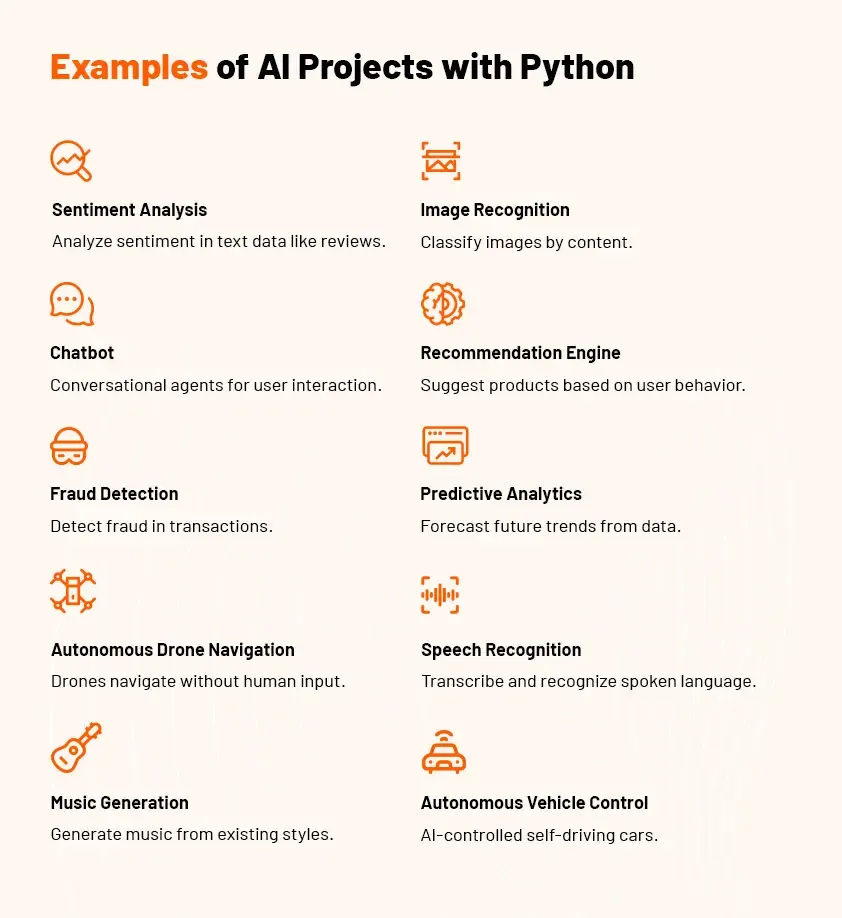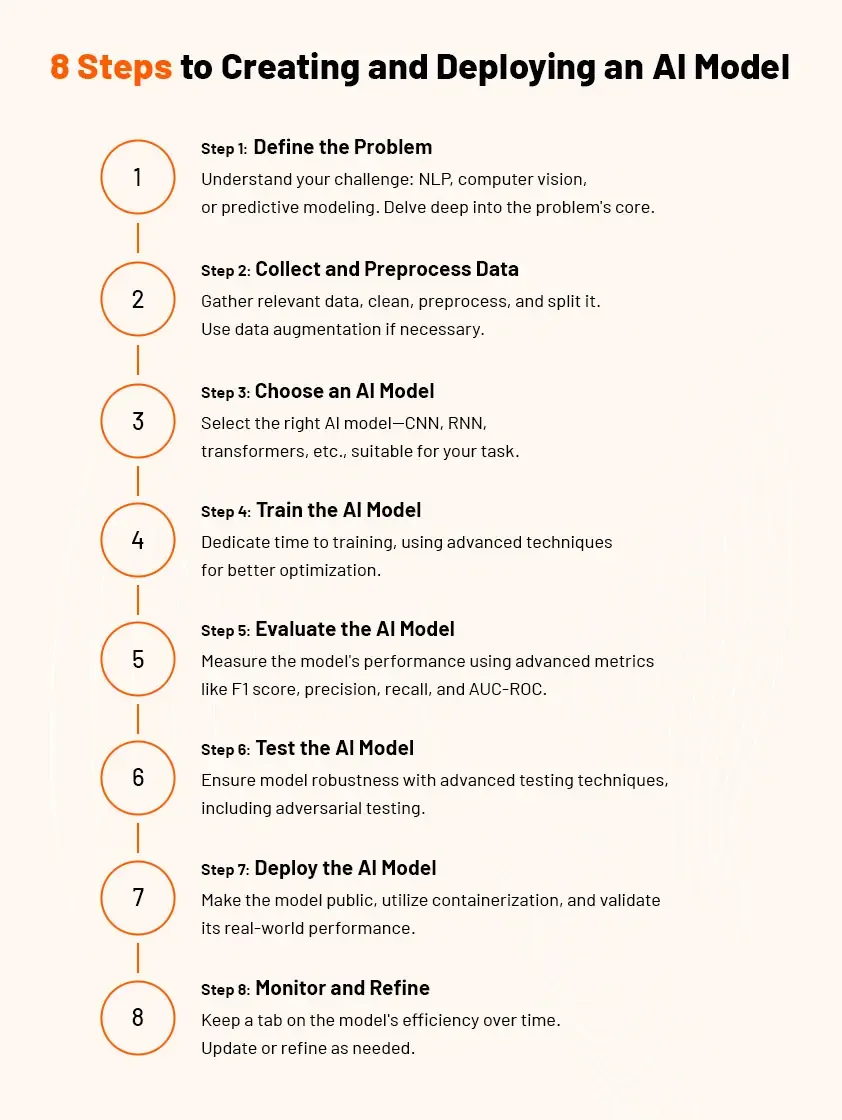
Maria Chojnowska
8 February 2024, 5 min read

What's inside
- Understand the Basics of AI
- Examples of AI Projects with Python
- How to Create an AI with Python?
- Final thoughts
- Contact Us
Artificial Intelligence (AI) has become integral to our lives, from virtual assistants like Siri and Alexa to self-driving cars. Building an AI can seem daunting, but it can be a fulfilling and rewarding experience with the right tools and knowledge.
In this blog post, we will provide a step-by-step guide on creating an AI using Python, one of the most popular programming languages for AI.
Understand the Basics of AI
Before building an AI, it is crucial to understand what AI is and how it works.
For more detailed knowledge, read our blog post What Is AI, and Is It Out of Your League? Right now, I will cover the basic definition.
Artificial Intelligence is the simulation of human intelligence in machines programmed to perform tasks that would otherwise require human assistance. AI involves developing algorithms and computer programs that can analyze data, learn from it, and make decisions based on it.
AI aims to create intelligent machines that mimic human cognition and behavior, such as problem-solving, decision-making, natural language processing, and perception.
Since AI is rapidly evolving, keeping up with the latest developments and trends is hard. Even though breakthroughs and innovations are constantly made, we must remember that AI is a tool, not a replacement for human intelligence. While AI systems can indeed perform many tasks more efficiently than humans, they are still limited by their programming and the data they are training on.
Using AI with human intelligence is important to achieve the best results.
Examples of AI Projects with Python
If you’re interested in working on an AI project with Python, there are plenty of exciting possibilities and opportunities.

Choose one that interests you, and start exploring! Remember that these are just a few examples of many exciting AI projects you can work on with Python.
How to Create an AI with Python?
Step 1: Define the Problem
The first step in creating an AI is to define the problem you want to solve. This may involve natural language processing, computer vision, or predictive modeling.
Advanced users may work on complex problems requiring deep learning techniques. It is essential to deeply understand the problem before moving to the next step.
Step 2: Collect and Preprocess Data
Data is the foundation of any AI project. Sunscrapers blog provides tips on collecting and preparing data, including data cleaning and preprocessing.
As an advanced user, you may deal with large datasets that require preprocessing before using them in an AI model. This may involve cleaning the data, transforming it into a suitable format, and splitting it into training, validation, and testing sets. You may also need to use techniques such as data augmentation to increase the size of your dataset.
Step 3: Choose an AI Model
As an expert, you have many AI models, including convolutional neural networks, recurrent neural networks, and transformers. It's important to choose an AI model that is suitable for your specific problem and dataset. You may need to experiment with different models and hyperparameters to find the one that performs best.
Step 4: Train the AI Model
Training an AI model can be time-consuming, especially for complex models and large datasets. With a deep understanding, you may need to use techniques such as distributed training to speed up the process. You may also need to use advanced optimization algorithms such as Adam or RMSprop to improve your model's performance.
Step 5: Evaluate the AI Model
Once your model is trained, it's important to evaluate its performance using validation and testing data. As an advanced user, you may need to use advanced metrics such as F1 score, precision, recall, and AUC-ROC to evaluate your model's performance. You may also need to use techniques such as cross-validation to get a more accurate estimate of your model's performance.
Step 6: Test the AI Model
Testing your AI model is a critical step in the development process. As an advanced user, you may need to use advanced techniques such as adversarial testing to identify any weaknesses in your model. You may also need to use techniques such as model ensembling to improve the robustness of your model.
Step 7: Deploy the AI Model
Once you're satisfied with your AI model, the final step is to deploy it in the real world. Which basically means making it available for use by others. As an advanced user, you may need to use techniques such as containerization to ensure your model can be deployed and scaled.
You may also need to use techniques such as A/B testing to validate your model's performance. Consider using other tools and methods like GPUs, TPUs, and distributed computing.
Step 8: Monitor and Refine
Monitor the performance of your AI system over time and refine it as necessary. This could involve updating the model with new data or retraining it with different algorithms.
Final thoughts
Python has become one of the most popular languages for AI due to its simplicity, flexibility, and powerful libraries and frameworks available to help you create advanced AI models, such as TensorFlow, Keras, and PyTorch.
By exploring the different ways Python is used in AI, you can gain a deeper understanding of AI and the tools available for building intelligent systems.
Whether you are a beginner or an experienced AI developer, Python has something to offer everyone.
Creating an AI with Python can be a challenging but rewarding experience. By following the steps outlined in this blog post, you can create your own AI project and gain a deeper understanding of AI and machine learning.
Building an AI takes time and patience, but you can create something remarkable with the right tools and knowledge.
Contact Us
At Sunscrapers, we are always excited to see the innovative projects you work on in this field.
We are available to support you in your AI endeavors. Whether you are just starting or need help to refine your existing project, please do not hesitate to contact us for assistance.



